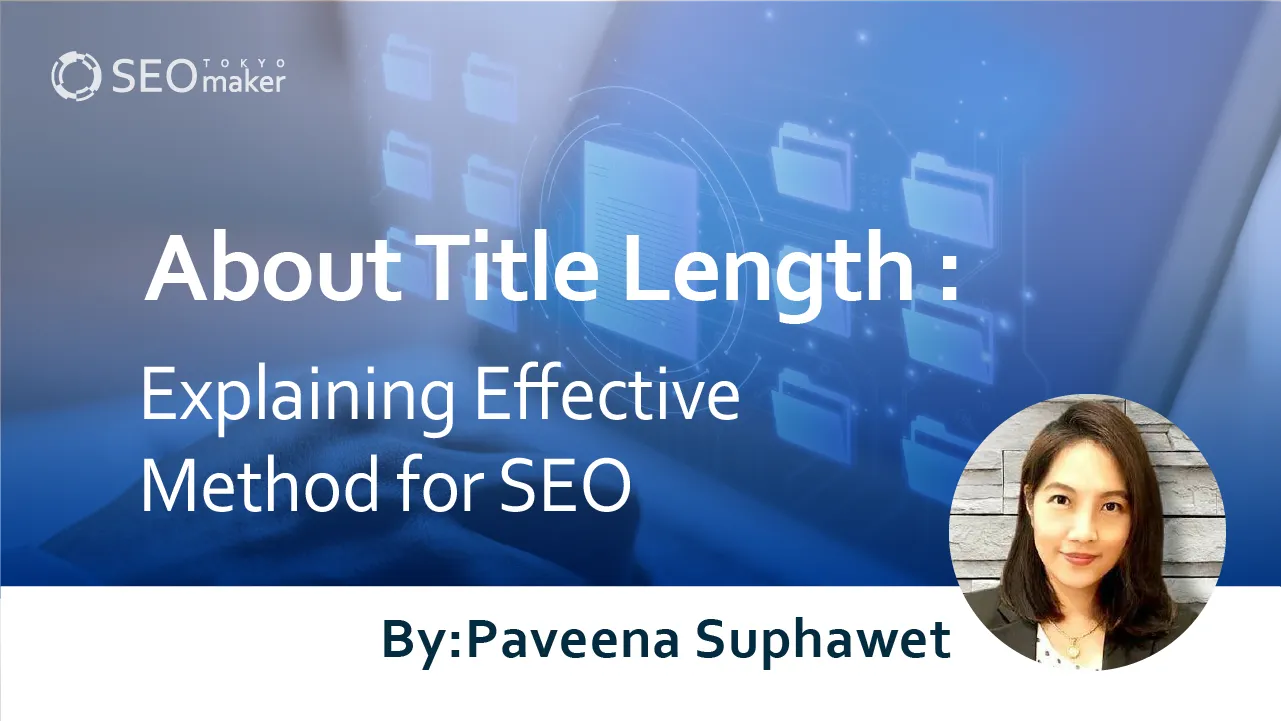About Title Length : Explaining Effective Method for SEO
contents
- 1 The Basics of SEO Strategy: What is a Title?
- 2 How to Create Effective SEO Titles
- 3 Tips for Differentiating Your Titles from Competitors
- 4 Common Questions About SEO and Titles
- 4.0.1 Q: Will Changing the Title Improve Search Ranking?
- 4.0.2 Q: Why Did the Title Displayed in Search Results Change Automatically?
- 4.0.3 Q: Can the Title and H1 Tag be the Same?
- 4.0.4 Q: Can Symbols or Spaces be Used in Titles?
- 4.0.5 Q: Is It Okay to Include Multiple Keywords in One Title?
- 4.0.6 Q: Is it a Long Title Negative?
- 5 Summary

In the realm of Search Engine Optimization (SEO), titles hold significant importance. They serve as a crucial indicator for search engines like Google to understand the content and theme of a page.
However, deciding on the content of a title, including its length, can be challenging. This article delves into the creation of effective SEO titles.
The Basics of SEO Strategy: What is a Title?
A title refers to the text displayed in search results and at the top of the browser.
For instance, a search for “Mount Fuji” on Google might display results like “Mount Fuji Official Site” or “Mount Fuji – Wikipedia.” These are examples of titles.
Although the impact of HTML tags on SEO has diminished over time, search engines continue to prioritize title tags.
Titles are crucial not only for search engines but also for users. They decide whether to click on a web page based on the title displayed in search results. Therefore, webmasters and copywriters must carefully craft the optimal title.
How to Write a Title Tag
In markup languages like HTML or XML, tags are used to denote elements or attributes. For example, to write a title, you would use the “<title></title>” tags.
When using the title tag, it should be placed within the head tag, as follows
<head>
<title>Enter Title Here</title>
</head>
Typically, the title tag contains a summary of the web page’s content. Search engines analyze the text within this tag to grasp the theme and content of the page.
Why Titles Are Important for SEO
Titles are critical in SEO for three main reasons
-They impact search rankings.
-They influence click-through rates (CTRs).
-They often become anchor text.
In fact, the American SEO firm Moz emphasizes the importance of selecting the right title for both search engines and users. Let’s explore each reason in detail.
Reference Page: Title Tag – Moz
Impacting Search Rankings
Titles are crucial for accurately conveying the theme and content of a web page to search engines. Search engines analyze the keywords and content within titles to determine the page’s theme. Thus, setting the appropriate title is a fundamental aspect of SEO.
Influencing Click-Through Rates
The information in the title tag is directly displayed in search results. This means users decide whether to click on a web page based on its title. An attractive title can lead to higher click-through rates, while a less appealing one may decrease them.
Even slight fluctuations in click-through rates for keywords with high search volume can significantly affect traffic.
Titles are akin to the spine of a book. When choosing from a vast selection of books in a bookstore or library, you naturally gravitate towards those that clearly meet your needs. It’s impractical to check the contents of every book, so you’ve likely chosen books based on their spines multiple times.
Even without considering SEO, the marketing impact of a well-crafted title is evident.
Becoming Anchor Text Easily
Titles are also used when sharing links on social media platforms like Twitter and Facebook or on blogs like Hatena. An intriguing catchphrase paired with an image can prompt clicks, especially on social media where buzz marketing—generating word-of-mouth—comes into play.
Often, when links are shared, the title becomes the anchor text, which can enhance SEO effects through backlinks.
Anchor text can be checked in the Links menu of Google Search Console, allowing you to see how your site is referenced.
Today, SEO specialists must focus not only on content but also on social media. The title and images of a site are key tools for disseminating information on social media. Outstanding content can attract traffic from both search engines and social media.
How to Create Effective SEO Titles
When crafting a title, it’s crucial that the content of the article matches the title itself. If users click on a title only to find completely unrelated content, they will not be satisfied, leading to increased bounce rates.
Choosing the right title can be challenging, but please adhere to the following eight guidelines.
-Ensure the title matches the page content
-Include keywords
-Avoid irrelevant keywords
-Make each page’s title unique
-Keep titles around 30 characters
-Place keywords towards the beginning
-Avoid repeated use of the same keywords
-Exact matches are stronger
Aligning the Title with Page Content
The most important aspect is reflecting the content of the page in the title.
Even if you’re writing long-form content for comprehensive SEO, there should be a core piece of information. If there’s no central theme or if there are multiple, consider rewriting or splitting the content. The title should convey the core information of the content.
Often, titles are decided before the content is created. However, the correct process is to create the content first, then review the content to determine the title.
Incorporating Keywords
In content SEO, each piece of content should be associated with a specific keyword, which must be included in the title.
There can be situations where multiple keywords are targeted. For middle keywords, use two words, and for small keywords, use two to four words. Ensure all are included.
Good Example: “How to Choose a Watch”
Poor Example: “The Method to Obtain Your Ideal Watch”
In the good example, the keyword is succinctly included, and the content’s subject is clear. Although you can add more detail, this is sufficient for clarity. The poor example might intend the same meaning but is less clear.
Post the 2019 BERT update, search engines can rank content highly even without exact keyword matches, thanks to improved understanding of language nuances. Therefore, it’s possible to rank without using the exact keywords, though incorporating target words still tends to be more effective and is recommended over attempting to rank without them.
Exclude Irrelevant Keywords
Avoid including unrelated or only slightly related keywords in your content. Including multiple keywords can misalign with search intent or change the meaning entirely.
Stick to including only the necessary information as succinctly as possible.
Good Example: Choosing a Watch | Prioritizing Functionality, Brand, or Looks
Poor Example: How to Choose a Watch | For Furniture & Appliances, Visit Company XYZ
The good example effectively incorporates strong related keywords like “functionality,” “brand,” and “looks” related to “choosing a watch.” The poor example inappropriately adds a company promotion after “how to choose a watch.”
While not always detrimental, mixing unrelated content such as “furniture” and “appliances” with “watch selection” is unnecessary. Including the company name at the end of a title is common, but its placement should be thoughtfully considered for each page.
Make Every Page Title Unique
It’s essential to set a title for every page, but it’s critical that no two titles are the same across the website. Each must be unique.
Having duplicate titles can confuse search engines about which page to prioritize, potentially diluting the effectiveness of your SEO efforts and not reflecting the true search ranking of your site.
Although instances of identical titles are rare nowadays, it’s a critical consideration for sites built over a decade ago that haven’t been updated or revised since then.
Limit Title Length to About 30 Characters
There’s no strict limit on how many characters a title tag can contain, but aiming for around 30 characters is ideal. This guideline is based on how search results display titles, with anything beyond 30 characters potentially being truncated with an ellipsis (“…”). Users decide whether to click based on the title, so ensuring it conveys the message within 30 characters can improve click-through rates.
Search engines and devices may display different lengths of titles, and Google frequently updates its display standards. Thus, treat 30 characters as a flexible guideline rather than a strict limit.
Place Keywords at the Beginning
Placing your target keywords at the start of the title serves two purposes: aiming for an SEO boost and preventing truncation.
While the impact of keyword placement on SEO has diminished, positioning your target keywords near the beginning of the title is still considered beneficial. It’s a tendency rather than a rule.
Furthermore, since titles longer than 30 characters may be cut off in search results, placing keywords at the end risks them not being seen by users.
Good Example: How to Choose a Watch | Considering Functionality, Brand, or Aesthetics?
Poor Example: Considering Functionality, Brand, or Aesthetics? How to Choose a Watch
Both examples convey the same message, but the placement of “How to Choose a Watch” significantly alters the impression. First impressions directly influence click-through rates, so it’s advisable to position keywords at the forefront.
Avoid Repeating the Same Keyword
Given the recommendation to keep titles around 30 characters, there’s little room for repeating the same keyword multiple times. Moreover, there’s little benefit to doing so; aim for natural-sounding Japanese that’s concise and to the point.
While repetition doesn’t necessarily result in a negative evaluation, exceeding two or three instances could be problematic. (Not allowed to repeat more than 3 times)
Good Example: How to Choose a Watch | Considering Functionality, Brand, or Aesthetics? Poor Example: How to Choose a Watch | Choosing by Functionality, Choosing by Brand
The good example is succinct and to the point. The poor example unnecessarily repeats the keyword, making the title cumbersome and unnatural.
Exact Match Titles Have More Strength
A subtle but impactful technique for both titles and targeted keywords is that exact matches are stronger, and the closer the words are to each other, the better.
For example, considering the target keyword “affordable SEO,” here are good and poor examples of how it might be used:
Good Example: “Affordable SEO Services by Tokyo SEO Maker”
Poor Example: “For Affordable Rates on SEO Services, Choose Tokyo SEO Maker”
While both examples essentially mean the same thing, in the good example, “affordable” and “SEO” are connected, whereas, in the poor example, they are separated. As a rule of thumb, try to keep related words together whenever possible.
Furthermore, when strategizing for multi-word keywords, the positioning of these words also matters. While you may not always be able to place related keywords next to each other due to content structure, aim to keep them as close together as possible.
Tips for Differentiating Your Titles from Competitors
Here, we’ll offer some tips on crafting titles that set you apart from competitors
Tailor to Your Target Audience
Creating titles that resonate more with your target audience than those of competitors is crucial. Rather than focusing solely on search keywords, consider incorporating expressions or phrases frequently used by your existing customers.
Convey Benefits Clearly
While avoiding exaggerated claims, it’s important to clearly communicate the benefits. By providing clear and understandable titles, you can improve click-through rates. Highlight your company’s reliability or unique selling propositions in your titles.
Focus on Solving Problems
Many users search online to find solutions to their problems. Therefore, create content that addresses these issues and reflects this in your titles. This approach makes your web page valuable to users and helps differentiate it from competitors.
Common Misconceptions About SEO and Titles
Titles play a significant role in SEO, making them one of its most crucial elements. However, even web managers often have misconceptions about titles. Here, we’ll clarify some commonly misunderstood aspects:
Titles Should Not Be Changed Once Set
Many believe that once a title is set, it should not be changed. However, if there are changes to the content or theme of a web page, updating the title accordingly is necessary. Regularly reviewing and updating titles can lead to improved click-through rates and higher search rankings. Just ensure that any changes to titles accurately reflect the content of the web page.
Keeping It Short is Better
It’s best to keep titles as concise as possible, but overly short titles that become ambiguous are counterproductive. Titles should be written with clarity in mind, ensuring they don’t lead to user confusion and accurately convey the content.
Extreme Sensationalism Should be Avoided
While sensational titles might temporarily increase click-through rates, extreme expressions can erode trust with users and search engines, leading to negative impacts.
Reusing Titles is Improper
Using the same title across multiple pages is inappropriate because it makes it difficult for search engines to distinguish between pages with identical titles, potentially diluting the value and hindering the correct search ranking.
Common Questions About SEO and Titles
Titles are a critical aspect of SEO strategy. Here we have compiled some frequently asked questions about titles.
Q: Will Changing the Title Improve Search Ranking?
A: If the correct title hasn’t been used, correcting it can improve rankings. Many sites have seen rank improvements by just changing titles according to our internal audit recommendations, especially if they hadn’t done any SEO before.
However, if SEO has already been applied and titles optimized, minor changes or adjustments are unlikely to have a significant impact.
Search rankings are determined by complex factors, so even if changing the title affects rankings, other reasons below could also contribute to fluctuations.
-Changes due to Google’s fluctuations
-Competitors modified their content
-Moved due to fluctuations in search rankings
-Became temporarily topical
Considering further, there are many factors that come to mind. The challenging aspect of SEO is that making changes to your own site does not necessarily relate to changes in ranking.
Q: Why Did the Title Displayed in Search Results Change Automatically?
A: Google sometimes changes titles automatically. It might alter the title based on content analysis for display in search results, which can be frustrating if it deviates from the intent.
There’s no foolproof way to prevent automatic changes, but improving the title or content might help Google display it as intended.
Additionally, when internal links are overly concentrated with the same anchor text, the anchor text may automatically become the title as is. In such cases, it’s advisable to review the internal links.
Q: Can the Title and H1 Tag be the Same?
A: They can be the same, but it’s recommended to vary the keyword arrangement or phrasing.
Titles are used in search results and on social media, while H1 tags serve as headings within content. Their uses differ, but matching them isn’t inherently problematic if they serve the same purpose. However, varying them could be beneficial.
Also, note that titles may include the company or service name. However, this is not necessary in the H1 tag, so please be cautious of that. In the following example, the title is acceptable, but in the H1, “Tokyo SEO Maker” is not needed.
Title: The Basics of SEO | Tokyo SEO Maker
H1: The Basics of SEO
Q: Can Symbols or Spaces be Used in Titles?
A: Symbols and spaces can be used without issues, but avoid using symbols like 【】 for emphasis, as Google disfavors ranking content based on perceived importance. The title is an element of the content, so you can use symbols and spaces found within the content. However, try to limit the character count to around 30 characters. Using them sparingly for visual effect is fine, but avoid overusing brackets or symbols for emphasis.
Q: Is It Okay to Include Multiple Keywords in One Title?
A: It’s not recommended. Aim for one keyword per page. Enhancing the comprehensiveness of content can sometimes allow a single article to target multiple keywords. However, this contradicts the principle of one keyword per content, and is not recommended.
When creating content and deciding on a title, if there are multiple clear keywords, it might be better to split the article into several pieces.
Q: Is it a Long Title Negative?
A: A long title isn’t penalized, but aim for about 35 characters to avoid truncation in search results. As mentioned earlier, titles that are too long will not be fully displayed. The guideline of 30 characters for titles refers to the number of characters shown in search results, so if it’s longer, it will simply be truncated.
In fact, even for high-ranking searches, the title, followed by the company name, can significantly exceed 30 characters. However, this does not result in penalties or negatively affect the ranking.
Google does not rank based on the title alone but evaluates the content to determine the ranking.
Summary
There are various reasons why changing the title can affect rankings. However, if changing the title actually alters the ranking, it should be considered that the modification has led to a better understanding of the content and a more accurate evaluation of it in relation to the keywords. In fact, improving rankings by changing the title usually requires that the content be of good quality to start with. These details about titles may be difficult to convey to those not familiar with SEO (and even those who think they are), and can often be misunderstood. Yet, “improving search rankings by changing the title” can indeed occur, especially with websites new to SEO strategies.










![What is a Description? Explaining the Meaning, Writing Style, and Changing Word Count – [2023 Edition]](https://www.switchitmaker2.com/en/wp-content/uploads/2024/09/what-is-description.webp)










